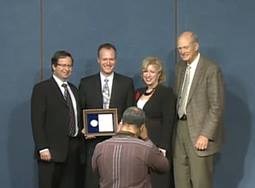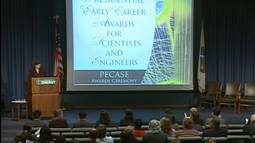Celebrating Achievement . . . and Potential
Encouragement lasts a moment. But achievement lasts a lifetime. That's especially true of researchers supported by the U.S. Department of Energy (DOE). And that's the goal of the Presidential Early Career Awards for Scientists and Engineers (PECASE), which recognizes individuals who show exceptional potential for accomplishment while early in their research careers.
Today, DOE celebrated its 13 winners of the PECASE awards—eleven supported by DOE's Office of Science and two supported by DOE's National Nuclear Security Administration: individuals who have accomplished much, and who are poised to achieve greatly.
Some made large strides in the extremely small. Alysia Marino of the University of Colorado won for research focused on measurements of the neutrino. These ghostly particles have tiny masses and no electric charge, but are one of the fundamental building blocks of the universe. Christian Bauer of Lawrence Berkeley National Laboratory (Berkeley Lab) won for developing new techniques that increase the precision of the theoretical predictions used in understanding results observed experimentally at particle colliders. Evgenya Simakov of Los Alamos National Laboratory is working on advanced particle accelerators, too, developing new structures that improve the quality and intensity of particle beams.
“These individuals, and their fellow 2010 PECASE winners, are using science and technology to make our nation, and world, a better place.”
Feng Wang of the University of California, Berkeley (UC Berkeley), made essential contributions to our understanding the optical and optoelectronic properties of the tiny sheets and tubes of carbon known as carbon nanomaterials. Gang Liu of the University of Illinois at Urbana-Champaign, whose work was funded through the National Nuclear Security Administration (NNSA), collaborated in the development of new ways to study surfaces and extremely thin films in exquisite detail via Surface Enhanced Raman Spectroscopy techniques. His work has a variety of potential national security applications, such as in the area of bio-detection. And Cornell University's David Erickson has made discoveries and developed innovations in the fields of microfluidics and nanofluidics; the flow of fluids through extremely small places, the size of blood vessels and even smaller. His work might see application in energy production as well as medical science and homeland security.
Other PECASE winners went for accomplishments at a slightly larger scale. For instance, Carole Dabney-Smith of Miami University in Ohio is trying to better understand how plants assemble their "solar panels," the energy-harvesting complexes of photosynthesis. Wei-Jun Qian of Pacific Northwest National Laboratory is studying proteomics. Proteins are the essential mechanical machines of cells and Qian is looking to understand how cells of a biofuel-producing type of fungi turn those machines on and off at the right times so the cell has the right materials in the right place at the right times, giving it the ability to do what it needs to do when it needs to do it. Daniel Fredrickson of the University of Wisconsin-Madison is leading a team that's finding new ways to build new and complex metal alloys, which may see use in a variety of energy applications. Victoria Orphan of the California Institute of Technology is studying how partnered groups of environmental microbes consume methane, a greenhouse gas that has a significant impact on global atmospheric chemistry.
 Department of Energy
Department of Energy
From L to R: Dr. Steven Koonin (Under Secretary for Science), Dr. Christian Bauer (PECASE Awardee), Neile Miller (NNSA Principal Deputy Administrator), and Dr. William Brinkman (Director of the Office of Science)
UC Berkeley's Fotini Chow, whose work was funded through the NNSA, took a bigger view of the atmosphere. She's established a research program focused on simulating atmospheric turbulence over complex terrain, which might be used to predict plume of releases of hazardous materials as well as emissions of air pollution, and also has applications to wind energy and regional climate change. Her fellow PECASE winner, Christiane Jablonowski of the University of Michigan, is pushing the frontiers in climate and weather modeling by introducing "Adaptive Mesh Refinement techniques" into future-generation atmospheric models, which enable scientists to focus their computational resources on features or regions of interest like the eye of a tropical cyclone or over mountainous terrains. Lawrence Livermore Lab's Greg Bronevetsky works on computer simulations, too. His research focuses on improving the performance and productivity of high-performance computers used to study a wide variety of natural phenomena such as nuclear fusion, the climate, and biological processes.
These individuals, and their fellow 2010 PECASE winners, are using science and technology to make our nation, and world, a better place. Through the Office of Science and NNSA, they've accomplished much, and are poised for much more. They're living proof that encouragement lasts a moment…but accomplishment lasts a lifetime.
For more information about the PECASE awards, please go to: http://science.energy.gov/about/honors-and-awards/pecase/. You can view the PECASE ceremony here: http://webcast.streamlogics.com/audience/index.asp?eventid=84307496. And for more information on DOE's Office of Science, please go to: http://science.energy.gov/.
Charles Rousseaux is a Senior Writer in the Office of Science.


 Department of Energy
Department of Energy